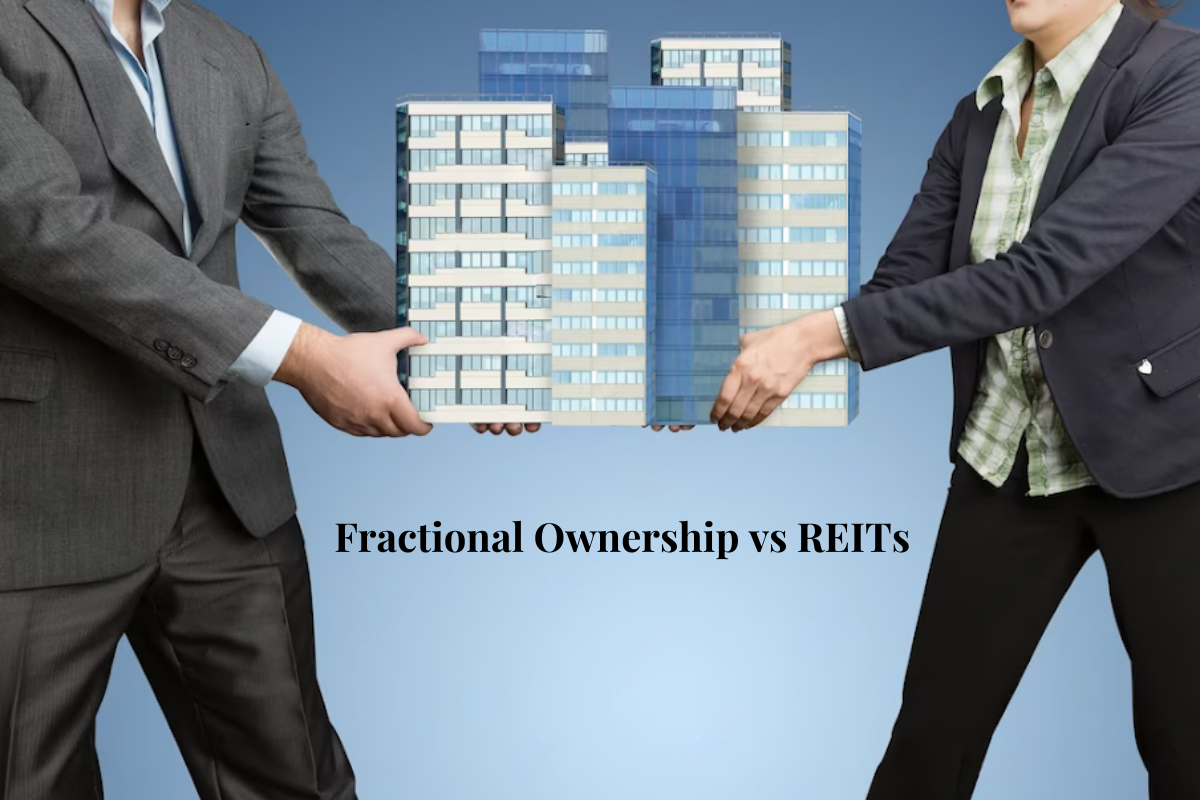How is Fractional Ownership in Commercial Real Estate changing?
Do you know, in India, the market size of fractional ownership in 2020 was 5.4 billion USD and is projected to grow with an annual growth rate of 10.5% reaching a significant value of 8.9 billion by the year 2025.
Fractional ownership in commercial real estate has been changing the real estate industry by creating investment possibilities by granting access to the world of premium commercial properties. This option of real estate investment is rising in popularity for its substantial returns, straightforward tracking and other diversification advantages.
Definition Of Fractional Ownership In Commercial Real Estate.
Fractional ownership in commercial real estate industry is a smart ownership concept very similar to REITs with minute differences, as REITs are publicly listed entities on only income-generating properties, fractional investing involves individual investors pooling their funds to collectively buy real estate.
Fractional ownership in commercial real estate involves the division of commercial property into smaller, tradable shares. The primary objective of fractional ownership in commercial real estate is often to rent out the property and earn shared rental income. However, some investors are also attracted to the convenience of having dedicated office spaces for specific purposes.
Unlike traditional real estate investments, fractional ownership permits individuals with limited capital to invest in high-value properties that were previously difficult to access individually. Shared ownership facilitates rental income distribution with full capital gains when the property appreciates.
Importance of understanding the evolving landscape of smart ownership.
Understanding the evolving landscape of fractional commercial real estate is of paramount importance as it offers various unique opportunities to investors that have been emerging. By staying abreast of its emerging development, individuals can capitalize on the potential for high returns and portfolio diversification.
It is necessary for the investors of fractional ownership in commercial real estate to grasp the nuances of this investment, including the benefits, risks, and factors influencing its growth.
Investors should grasp the nuances of fractional ownership, including the benefits, risks, and factors influencing its growth. By staying informed, investors can navigate the dynamic market and capitalise on emerging trends and opportunities. Understanding market trends, demand dynamics, and regulatory changes allows for informed decision-making and risk mitigation.
Moreover, staying updated on legal and regulatory compliance changes ensures investors remain compliant with relevant laws and regulations related to fractional investment property.
Traditional Fractional Investing Models.
No doubt why the current model of fractional investing is considered to be smart ownership when compared to traditional fractional investment property. Historically, traditional fractional ownership models included private partnerships and real estate investment trusts (REITs).
In a Private partnership, a group of investors collectively purchase and own a commercial property, they share the responsibilities and rewards of the purchased property. Whereas, REITs are those publicly traded companies that own and operate on income-generating real estate assets.
Brief overview of traditional fractional ownership in commercial real estate.
In the upcoming five years, Fractional ownership in commercial real estate in India is expected to witness significant growth, with an estimated increase of 13 percent to 16 percent. This surge is driven by the rising number of fractional owners participating in the market.
You will find several factors that contribute to this anticipated boom, the rise in government support for increased demand for office spaces, the growing presence of major institutional investors, and substantial foreign investments in numerous trade projects. All these factors together create a favourable environment for persistent capital appreciation.
In India, Fractional ownership in commercial real estate prioritizes the grade-A properties that are frequently leased to multinational corporations, banks, warehouses, factories, and information technology establishments with substantial budgets.
When it is compared to residential tenants, fractional investment property usually commits to longer rental leases of four to five years, offering the fractional investing owners stable and consistent rental income. Moreover, commercial tenants tend to maintain the premises well, as they use the space for their offices and tailor it to their specific requirements.
This commitment from commercial tenants leads to a higher likelihood of lease renewals rather than frequent relocations. For this reason, fractional owners find investing in commercial real estate much more appealing, considering the steady rental income and the constant rise in real estate market values. This fine combination of regular rental returns and the property's appreciation makes fractional commercial real estate investment an attractive proposition for multiple stakeholders.
Benefits and limitations of traditional fractional investing models:
Before we get to the conclusion of how traditional fractional investing models let’s go through the benefits and limitations of traditional models:
Benefits of Traditional Models:
- Similarly to the current model of fractional ownership in commercial real estate, Traditional fractional investment property also allows investors to diversify their portfolios by owning shares in multiple commercial properties, which helps them to spread risk across different assets and locations, thereby minimizing the impact of market fluctuations.
- Traditional Model of fractional investment allows an investor to acquire constant stable rental income.
Limitations of Traditional Models:
- Traditional models of fractional investment have limited liquidity. Investors might face challenges selling their shares, especially in illiquid markets, because traditional fractional ownership models could be time-consuming.
- Traditional fractional investment property often involved complex legal and financial structures, which might have deterred some potential investors. As a result, understanding these structures and their implications required expertise and professional advice, which took extra effort and extra cash for an expert to hire.
Examples of successful traditional fractional ownership in real estate projects.
Even after limitations, several traditional fractional real estate investment projects have been successful in the past. Some of the projects typically involved prestigious office buildings, luxury hotels, and other large-scale commercial developments. Investors here enjoy stable rental income and, in some cases, significant capital appreciation over time.
Roofstock is a company that provides traditional partial ownership.
Emerging Trends in Fractional Ownership in Real Estate Investment.
The emerging trends in fractional ownership in commercial real investment have given investors ample amount of opportunities to explore the world of premium properties. Furthermore, the involvement of technological approaches to it has also bolstered fractional investing.
The introduction of technology such as blockchain and smart contracts has facilitated secure and transparent ownership transfers which greatly enhanced the process. Through tokenization, the transactions related to fractional property investment occur efficiently on the blockchain, enabling seamless trade and ownership tracking.
-
Technological Advancements
Recent technological advancements have revolutionized fractional ownership in commercial real estate. the emerging trend of blockchain technology has scattered traditional investment models, creating innovative opportunities for earning.
Now, fractional ownership in real estate is possible by the decentralized and transparent nature of blockchain.
-
Introduction of blockchain and smart contracts in smart ownership
The incorporation of these edge-cutting technologies of blockchain and smart contracts has transformed various industries, and the industry of finance and investment is no exception. Blockchain, often referred to as the underlying technology of cryptocurrencies like Bitcoin, is a decentralized and transparent digital ledger that securely records transactions across a network of computers.
Smart contracts, on the other hand, are self-executing contracts with predefined terms and conditions. In simpler terms, Smart contracts are special contracts that execute automatically when the specified conditions are met.
With these technologies, traditional fractional investing has undergone immense transformation creating innovative solutions to conventional problems. Blockchain and smart contracts technologies have unlocked novel possibilities for investors to invest in new models of investment, such as smart ownership and tokenization, which offer unprecedented opportunities for individuals to participate in previously exclusive markets.
-
Tokenization and fractional property investment on the blockchain
Tokenization, commonly known as blockchain fractional ownership, is a new technological investment concept that involves breaking down tangible or intangible assets into smaller units, which are then represented by digital tokens on a secure and decentralized blockchain network. The digital tokens are equal to a fraction of the physical real estate asset. Fractional real estate allows numerous investors can now hold ownership stakes in valuable assets without the need to acquire them in their entirety.
Tokenisation cannot be overstated in fractional ownership as it serves as the backbone of it. The blockchain technology of tokenization ensures a transparent and immutable record of every transaction involving these digital tokens. This transparency mitigates the need for intermediaries, making the investment process more efficient and cost-effective.
-
Increased transparency and efficiency
Blockchain-based fractional ownership offers increased transparency bringing a worldwide change in the commercial real estate of fractional ownership, while all transactions are recorded on a decentralized and immutable ledger. Investors can get access to real-time data on property performance, market trends, and ownership history whenever they want.
Moreover, smart contracts' effective approach to automate administrative tasks, such as rental distribution and voting on property decisions, reducing paperwork and human errors creates a reliable environment for the investors.
-
Digital Investment Platforms
Recently, the growth of digital investment platforms has sparked a transformation on how investors can get access to fractional ownership opportunities. These digital investment platforms provide user-friendly interfaces that allow investors to explore various properties, conduct due diligence, and make investments with ease.
-
Growth of online platforms for fractional ownership
The online platforms for fractional real estate ownership have been remarkably growing from within. Leveraging the power of the internet and technology to make it user-friendly in fractional investing of various assets, including real estate, art, luxury goods, and more.
Investors can easily explore this smart ownership with various options available on the platforms and choose their desired one. Plus, provides detailed information about the underlying assets, potential returns, and associated risks.
This online approach to fractional ownership has brought up new possibilities for a broader range of investors, allowing them to diversify their portfolios with smaller investment amounts.
-
Access to a wider range of commercial properties
The growth of online platforms for fractional ownership is expected to continue as more investors realize the advantages and patience of this innovative investment model.
Fractional ownership offers investors access to a wider range of premium commercial properties. By pooling funds, investors can participate in high-value commercial real estate projects that might have been difficult to access individually.
This investment model democratizes the market, offering opportunities to invest in diverse properties, sectors, and locations, thus expanding the potential for portfolio diversification and returns, and these happen online.
These platforms are set to play a significant role in democratizing investments and reshaping the way people participate in various asset classes.
-
Enhanced investor experience and ease of management
Fractional ownership in commercial real estate offers an enhanced investor experience and ease of management. It simplifies the investment process with user-friendly online platforms, making it easier to browse, select, and monitor investments.
Plus, investors get access to a diversified range of commercial real estate properties, spreading risks across various sectors and locations.
Furthermore, their professional management services often handle all the required property maintenance and rental management, relieving investors of their day-to-day responsibilities.
This convenience and support enhance the overall investor experience, making fractional property investment an attractive and best investment option.
-
Democratization of Commercial Real Estate Investing
“I am betting on the democratization of commercial real estate.”- John Cohn.
John Cohn, the Chief Marketing Officer of Cadre describes the measures Cadre is taking to further “the democratization of commercial real estate.” Cadre a prominent player in the investment space is decreasing the “minimums” required for investment, lessening fees.
One of the most exciting developments is the increased focus on providing liquidity opportunities. This means that investors will have more options to buy and sell their investments. Cadre is opening the door for more individuals to partake in the world of investment and seize the benefits it offers.
This allows individuals to participate in an exclusive investment of commercial real estate which was only confined to the domain of wealthy people or institutional investors. Fractional real estate investing allows retail investors and small businesses to partake in lucrative opportunities
Through fractional ownership and digital investment platforms, the doors to commercial real estate investing are flung wide open, inviting a diverse and inclusive community of investors to share in the wealth and potential offered by this thriving market.
-
Lowering investment minimums and entry barriers
In Commercial Real Estate, fractional ownership aims to make investing more accessible to a broader range of individuals by lowering investment minimums and entry barriers.
Now, fractional ownership in commercial real estate is changing due to the elimination of entry fees, making it attainable for people to participate in these investments and earn benefits from it.
-
Greater access for individual investors and small businesses
Fractional ownership has broken down all the barriers that once restricted access to commercial real estate investments. By reducing the investment minimums, both individual investors and smaller businesses can now participate in lucrative real estate opportunities.
This democratization of the fractional commercial real estate market paves the way for a more diverse and inclusive group of investors, fostering greater financial growth.
-
Diversification opportunities and risk mitigation
Fractional ownership become a powerful tool for investors to diversify their investment portfolio. It allows investors to spread their capital across multiple properties, asset classes, and geographic locations.
All these can minimize the risk and achieve a more balanced and resilient portfolio. It helps investors navigate through market fluctuations and potential uncertainties, ultimately increasing their chances of achieving sustainable and favourable returns.
Impact of Changing Regulations
Having a deep understanding of the regulatory landscape for fractional ownership in commercial real estate is crucial for conducting business successfully. As fractional ownership gains popularity, government authorities are keen to implement measures that protect investors and maintain market integrity.
Evolving regulatory landscape for fractional ownership
The regulatory landscape for fractional ownership in real estate is constantly changing. The authorities are closely advocating the developments around fractional ownership to ensure investor protection and market integrity.
The evolving regulatory environment aims to strike a balance between promoting innovation and safeguarding investor interests, establishing clear guidelines and standards to govern fractional investment property transactions and platforms.
Areas of focus in the evolving regulatory landscape include investor protection, compliance and due diligence, disclosure and transparency, licensing and registration, market integrity, and addressing the challenges of cross-border transactions.
As fractional ownership platforms leverage technologies like blockchain, regulators may develop specific guidelines to address the unique aspects of digital asset ownership and management.
Overall, staying informed about regulatory developments and complying with applicable laws is crucial for all stakeholders in the fractional real estate industry to foster a secure and trustworthy environment for investors and market participants.
Impact of regulatory changes on commercial real estate investing
Regulatory changes have a significant impact on commercial real estate investing. These changes dictate how commercial spaces can be used and developed properly, often leading to higher costs for buyers and sellers. These regulations cover various aspects, including zoning, taxation, and licensing laws. Zoning laws determine how properties can be used and what structures are allowed.
The zoning permits can be hard to get which significantly causes delays in the buying process. Taxation laws set the tax rates for owners and developers, while licensing requirements determine who needs to be licensed for certain industry-related activities.
When it comes to regulations, it also requires disclosing hazardous materials added in developing the property, leading to testing and clean-up before selling or renting.
Furthermore, there are Rent control laws, that have been implemented in some states, this creates a restriction on how much landlords can charge, which consequently affects profitability and tenant selection. However, you must understand that the effects of government regulations can differ from state to state.
Additionally, regulations can affect the availability of financing for projects, as lenders require assurance that all laws have been followed before approving loans. This can lead to additional paperwork and due diligence to address any legal concerns or liabilities associated with the properties or developments.
Environmental regulations can restrict construction or renovations to preserve resources and reduce pollution. Commercial entities may need additional permits for building changes.
Investors must also consider tax regulations, which can increase acquisition costs significantly.
Overall, understanding and complying with local laws beforehand is essential to ensure smooth transactions for all parties involved. Doing due diligence ahead of time will help everyone understand their rights and responsibilities under the law.
Examples of regulatory developments and their effects
Due to various needs and requirements to govern the sector of investment the need for regulatory developments has suddenly been prioritized. Some of the regulatory developments may include adjustments to tax implications, reporting requirements, and investor accreditation criteria. These changes can impact the overall feasibility of fractional property investments.
Tax implications:
Taxation laws are an important example of regulatory development in commercial real estate transactions. It is necessary to be aware of the location of your property because your location determines the taxes, and depending on that you are required to pay taxes according to the income it’s generated.
Plus, if you are planning to renovate or construct new buildings, there might be additional taxes you might required to pay, in order to obtain permits and get necessary documents.
It is essential to have a clear understanding of all relevant taxation laws before engaging in any transaction to avoid any unexpected financial implications.
Environmental laws:
Environmental protection laws are other laws essential in commercial real estate development. Their roles in safeguarding the environment from pollutants and contaminants play an important part. They have established various regulations to prevent environmental harm during commercial real estate activities.
For example, construction sites must adhere to particular guidelines to minimize air and water pollution, making sure about the preservation of endangered species and delicate ecosystems nearby. Property owners and lessees must also follow environmental regulations regarding waste disposal and maintaining energy efficiency standards for buildings.
Amendment process:
Apart from the above-mentioned laws, commercial real estate transactions must also consider amendment processes. Amendments involve changes to existing zoning ordinances or building codes that could impact the use of a property or area. If there is a proposed amendment that affects your property, it is crucial to comprehend its implications for your business before making a decision to accept or reject it.
Advantages and Considerations of Fractional Ownership in Commercial Real Estate.
Before jumping into any investment option it is necessary for you to look after the ins and out of it. Similarly, fractional ownership in commercial Real Estate also has a few advantages and considerations that one might consider before investing:
Increased liquidity and flexibility
Fractional investment property offers investors greater liquidity compared to other traditional real estate investments. By dividing the property into smaller fractions, investors can buy and sell their shares more easily, potentially capitalizing on favourable market conditions while making it more flexible.
Diversification and reduced risk
Fractional ownership in commercial real estate allows individuals to diversify their portfolios, reducing the risk associated with single-property investments. This diversification of property portfolios can provide stability during economic downturns or fluctuations in specific sectors.
Potential for higher returns
Furthermore, fractional ownership in commercial real estate in high-performing commercial properties can lead to attractive returns as well. Rental income and property appreciation add to robust long-term capital gains.
Considerations such as due diligence and property management
Due diligence of fractional ownership in commercial real estate is a must for mitigating potential risks. Also, one must keep in mind the property management process, as the cost and the responsibilities might vary based on the investment structure. Investors should consider outsourcing management tasks to experienced professionals.
Challenges and Future Outlook in fractional investment property.
Challenges and potential risks in fractional real estate.
- Market Volatility is one of the risks in fractional real estate one must consider. Fractional ownership can be influenced by market fluctuations, affecting property values and rental income. Investors must be prepared to weather such fluctuations and have a long-term investment perspective.
- Economic downturns can impact the demand for commercial properties, affecting investor returns. A well-diversified portfolio can help mitigate the impact of economic cycles.
- Tenant Occupancy Fluctuations can also be one of the challenges investors must face while fractional investing. Changes in tenant occupancy can impact rental income and cash flow. Investors should assess tenant stability and property occupancy rates before investing.
Future trends and developments in the fractional real estate industry:
In India, Real estate and gold have been considered a safe and reliable way to build wealth and financial independence. However, those modern residents stick to small pieces of land or flats due to lower rental returns compared to commercial assets.
Even during the Work From Home era, Grade A commercial real estate in India remains the top choice in the asset class for investors due to its strong fundamentals and resilience. Fractional ownership in commercial real estate has seen substantial equity investments in the past decade. REITs (Real Estate Investment Trusts) have become popular in India, with successful listings like Embassy Office Parks and Mindspace REIT.
The trend of fractional investing is growing because it provides a secure and feasible way to invest in Grade A office buildings. In this sector, multiple investors pool their funds to jointly purchase commercial properties, which are thoroughly cleared before ownership is distributed among the investors. This pleases the budget of investors well and in the future, it is expected to become a dominant investment trend in India.
Fractional ownership in commercial real estate generates higher rental revenue in contrast to residential apartments, investment safety due to the Grade-A quality of the underlying assets, increased liquidity as units can be sold on the secondary market platform, and higher chances for significant capital gains over the long term.
One attention-seeking factor about Commercial real estate is that, it offers a less volatile investment option compared to stocks and mutual funds, as lease agreements are usually for longer terms with periodic escalations to account for inflation. This stability and potential for regular income attract forward-thinking Indian investors.
Fractional ownership of real estate in India is bringing up a whole new investment opportunity for individuals, enabling them to invest in commercial properties subjective to their financial capabilities. It cuts through the dominance of high-net-worth individuals (HNIs) in commercial real estate investments and democratizes access to this asset class.
With the potential for higher returns and the security of Grade A properties, fractional real estate investing in India is gaining popularity and becoming an attractive option for a wider range of investors.
Predictions for the Future of fractional ownership in commercial real estate
The future of Fractional ownership in commercial real estate is adaptively changing because of the way people invest in real estate. Online property investment has become preferable, with the digital market experiencing a significant surge in favour among investors.
Technology is reshaping the landscape of real estate investing, offering a plethora of options, from crowdfunding platforms to digital marketplaces. The online fractional property investment world is evolving rapidly, providing investors with new and innovative ways to participate in the real estate market.
- The increase in the adoption of blockchain technology is a game-changer in fractional investing. Blockchain offers a safe and convenient platform for purchasing real estate using digital tokens, making investing easier and more feasible. As this trend gains momentum, more online platforms are adopting blockchain technology.
- Artificial intelligence (AI) is on the rise in fractional real estate investing, and its impact is only expected to grow through 2023 and beyond. AI offers investors valuable insights and aids in making well-informed investment decisions. From predictive analytics to automated property valuations, AI is enhancing the investor experience and boosting confidence in investing.
- Co-living spaces are a relatively new but rapidly growing trend in fractional ownership in the commercial real estate market. These spaces offer flexible and cost-effective real estate solutions for tenants while providing property owners with a reliable, long-term source of income.
- Virtual reality (VR) property tours are revolutionizing, letting investors explore properties. Through VR technology, investors can virtually tour properties and gain a realistic sense of what it would be like to live in and own them. This immersive experience assists investors in making reliable decisions.
- Sustainable real estate development is gaining significant traction in investment decisions. Investors are increasingly valuing eco-friendly and energy-efficient properties and are willing to pay a premium for sustainable homes. This trend of investment is expected to grow in the coming years, resulting in environmentally friendly real estate developments.
- Crowdfunding still continues to be a preferred option for investors due to its flexibility, as it allows investors to participate in various projects, including residential and commercial real estate, with smaller investments. With more real estate investment platforms offering crowdfunding options, this trend is likely to continue its upward trajectory beyond 2023.
Fractional ownership in commercial real estate has emerged as a transformative investment model, democratizing access to premium properties and diversifying investment opportunities. The growing landscape, driven by technological advancements, changing regulations, and increased accessibility, will continue to shape the future of fractional ownership. As investors explore this innovative strategy, they must be mindful of potential risks, conduct thorough due diligence, and seize the opportunities for diversification and growth.
Related Blogs from real-estate-investment
-1728312198.webp)
A complete guideline to know the purchase of property by NRI in India
-1727684160.webp)
All the key information about interest on loan for house property
 (1) (1)-1721317471.webp)
A comprehensive guide regarding types of real estate property that will make you intelligible
-1721135437.webp)
Top Strategies for Successful Property Investment: Maximizing Returns in Real Estate
-1714373785.webp)
Know Guwahati Property Tax Better To Have Saving And Investment Opportunities!

The Role of Technology in Fractional Investment in Real Estate
-1707824784.webp)
Legal Considerations for Fractional Real Estate Investors

Explore The Types Of Models In Fractional Investing

Diversifying Your Investment Portfolio with Fractional Real Estate

Fractional Ownership vs REITs- Which one is better?
-1706600552.webp)
What Would You Choose? Fractional Investment or Traditional Investment?

Best benefits of fractional Ownership- Learn more about Fractional property investment

How to Choose the Right Platform for Fractional Real Estate Investment?

Check out! How fractional ownership works for You. Now!

A New Era of Investment- Build Your Real Estate Portfolio With Fractional Investment

How is Fractional Ownership in Commercial Real Estate changing?
Latest Blogs from Buying

7 Mistakes to Avoid While Purchasing Land
Land purchasing is considered to be a crucial decision taken in a lifetime. So, avoiding the prospective mistakes during the process is also very important. Revealing those mistakes, this blog leads you toward the right approaches to buying land.

6 Common Factors to Mind Before You Buy Land
Buying a plot of land involves thoughtful considerations and good planning. This blog discussing six crucial factors that need to be considered before purchasing land will guide you throughout your land-purchasing journey.

Point of View of a Buyer: Journey of Purchasing Land
Being a land buyer, it is important to know the entire process of land purchasing including all the requirements and upcoming challenges. This blog discusses this process in a detailed way, making your land-purchasing experience smooth.

Add Comment